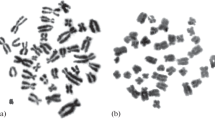Abstract
IN the grasshoppers and some other animals, nodes have been demonstrated in the bivalents, at the late prophase, by Sutton, McClung, Robertson, Wenrich, Janssens, etc. One of the Orthoptera, Chortophaga sp., has eleven bivalents and one univalent (X chromosome) at the late prophase of the maturation divisions in the spermatocytes. These are well shown in ironacetocarmine preparations. The writer found that the six largest bivalents showed 28 cases with one node to 19 with two nodes. The smallest five bivalents had only one node each. At each node it was obvious, as had been previously demonstrated by others, that one chromatid from each homologue seemed to pass to the other side, while the other chromatid remained on the same side.
Similar content being viewed by others
Author information
Authors and Affiliations
Rights and permissions
About this article
Cite this article
BELLING, J. The Nodes at the Reduction Division in Bivalents of Hyacinthus. Nature 119, 527–528 (1927). https://doi.org/10.1038/119527c0
Issue Date:
DOI: https://doi.org/10.1038/119527c0
- Springer Nature Limited





